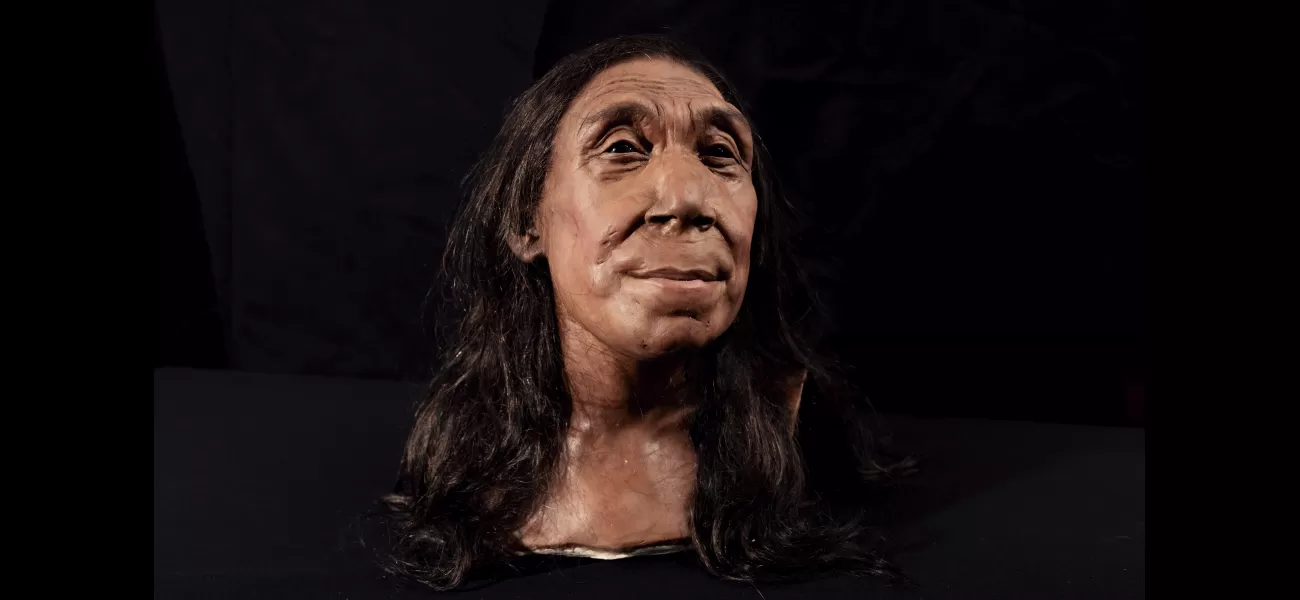A 75,000-year-old Neanderthal woman's face is shown in a new Netflix documentary.
Despite being 75,000 years old, she appears young and attractive.
May 1st 2024.

Allow me to introduce you to Shanidar Z, a remarkable Neanderthal woman who lived approximately 75,000 years ago. Thanks to the efforts of a team of archaeologists from the University of Cambridge and Liverpool John Moores, her face has been brought back to life in a new and fascinating Netflix documentary. The team painstakingly reconstructed her face from hundreds of bone fragments that were found scattered and flattened in a cave in Iraqi Kurdistan in 2018.
This particular cave, known as Shanidar Cave, holds special significance as it was a place where Neanderthals would lay their dead to rest. In fact, it was made famous in the late 1950s when several Neanderthal remains were discovered, suggesting that they had been buried in succession. The new documentary, titled "Secrets Of The Neanderthals," follows the team as they return to Shanidar Cave to continue their excavations.
Dr. Emma Pomeroy, a palaeo-anthropologist from Cambridge's Department of Archaeology, explains that Neanderthal skulls look quite different from human skulls. They have prominent brow ridges, lack chins, and have a projecting midface, resulting in a more prominent nose. However, the recreated face of Shanidar Z suggests that these differences may not have been as stark in life as previously thought.
The task of putting together the shattered skull was compared to the delicate process of dunking a biscuit in tea. The skull had been crushed, possibly by rockfall shortly after her death, and was flattened to a mere two centimeters when it was discovered by the researchers. They believe that it may be the top half of an individual previously uncovered in 1960.
Through the reconstruction of the skull, the team was able to determine that Shanidar Z was an older female with worn-down teeth, giving away her age. She was also estimated to be around five feet tall, with some of the smallest adult arm bones in the Neanderthal fossil record.
Back in the lab, lead conservator Dr. Lucía López-Polín carefully pieced together over 200 bone fragments to restore the skull to its original shape, including the upper and lower jaws. Dr. Pomeroy describes the process as a high-stakes 3D jigsaw puzzle, with each fragment gently cleaned and stabilized with glue and consolidant. Some bones were so delicate that they had the consistency of a tea-soaked biscuit.
The team also analyzed the site where Shanidar Z was laid to rest and discovered that she was placed in a gully created by running water. It appeared that the gully had been further hollowed out by hand to accommodate her body. Her posture suggests that she had been leaning against the side with her left hand curled under her head, and a rock behind her head acting as a cushion.
Professor Graeme Barker, who leads the excavations at Shanidar Cave, explains that the cave provides a unique opportunity to study human evolution. It was first used by Neanderthals and later by our own species, Homo sapiens, and can potentially shed light on why Neanderthals disappeared around the same time that humans spread to regions where Neanderthals had lived for thousands of years.
The new documentary, "Secrets Of The Neanderthals," will be available on Netflix worldwide on Thursday, May 2 at 8am. Through the incredible work of these archaeologists, we are able to catch a glimpse into the life and death of Shanidar Z, a Neanderthal woman who lived thousands of years ago.
This particular cave, known as Shanidar Cave, holds special significance as it was a place where Neanderthals would lay their dead to rest. In fact, it was made famous in the late 1950s when several Neanderthal remains were discovered, suggesting that they had been buried in succession. The new documentary, titled "Secrets Of The Neanderthals," follows the team as they return to Shanidar Cave to continue their excavations.
Dr. Emma Pomeroy, a palaeo-anthropologist from Cambridge's Department of Archaeology, explains that Neanderthal skulls look quite different from human skulls. They have prominent brow ridges, lack chins, and have a projecting midface, resulting in a more prominent nose. However, the recreated face of Shanidar Z suggests that these differences may not have been as stark in life as previously thought.
The task of putting together the shattered skull was compared to the delicate process of dunking a biscuit in tea. The skull had been crushed, possibly by rockfall shortly after her death, and was flattened to a mere two centimeters when it was discovered by the researchers. They believe that it may be the top half of an individual previously uncovered in 1960.
Through the reconstruction of the skull, the team was able to determine that Shanidar Z was an older female with worn-down teeth, giving away her age. She was also estimated to be around five feet tall, with some of the smallest adult arm bones in the Neanderthal fossil record.
Back in the lab, lead conservator Dr. Lucía López-Polín carefully pieced together over 200 bone fragments to restore the skull to its original shape, including the upper and lower jaws. Dr. Pomeroy describes the process as a high-stakes 3D jigsaw puzzle, with each fragment gently cleaned and stabilized with glue and consolidant. Some bones were so delicate that they had the consistency of a tea-soaked biscuit.
The team also analyzed the site where Shanidar Z was laid to rest and discovered that she was placed in a gully created by running water. It appeared that the gully had been further hollowed out by hand to accommodate her body. Her posture suggests that she had been leaning against the side with her left hand curled under her head, and a rock behind her head acting as a cushion.
Professor Graeme Barker, who leads the excavations at Shanidar Cave, explains that the cave provides a unique opportunity to study human evolution. It was first used by Neanderthals and later by our own species, Homo sapiens, and can potentially shed light on why Neanderthals disappeared around the same time that humans spread to regions where Neanderthals had lived for thousands of years.
The new documentary, "Secrets Of The Neanderthals," will be available on Netflix worldwide on Thursday, May 2 at 8am. Through the incredible work of these archaeologists, we are able to catch a glimpse into the life and death of Shanidar Z, a Neanderthal woman who lived thousands of years ago.
[This article has been trending online recently and has been generated with AI. Your feed is customized.]
[Generative AI is experimental.]
0
0
Submit Comment





